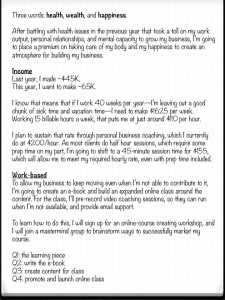
Talking about goals around the new year is always tricky business. Every publication from Cosmo to Forbes to Good Housekeeping is already happy to help you set up New Year’s “resolutions.”
You know, those things you tell yourself you’re going to do every year and then fail at/forget about/fall off the wagon with in about a week.
So let’s be clear. We are not talking about New Year’s resolutions here. I think New Year’s Resolutions are kind of silly anyway.
The Goals You and Your Business Need to Succeed
Setting goals for yourself and your business is always a delicate dance.
You never know what the future will bring—good or bad—and it’s easy for those unforeseen events to unhinge even the best-laid plans.
That’s why your business goals for the year need to take several different tracks.
Even when something comes up to keep you from meeting (or that makes sure you easily meet) your income goals early in the year, you’ll have other motivations to keep you going and working toward something important.
You need three main types of goals for the year ahead:
- overarching
- income-based
- work-based
Overarching themes…
…are not large to-do list items that you want to get done, such as writing an e-book, launching a new arm of your business, or updating your website. Those go in the work-based goal section.
Your themes will be your mantra for the year ahead. Even when you get off course, whether for positive reasons—-a huge new project coming your way from a client or collaborator-—or negative ones, like an illness or accident that keeps you from working for an extended period of time.
When you don’t have time to do a full review of your work and check if you are meeting your goals, or if you are just trying to decide on taking on a new project or client, you can easily remember and recite you main themes and see if you are on track.
Income-based goals…
…are deceptively simple. They seem easy to set, but that makes them equally easy to fail at.
You can decide that in 2014, you’re going to make $60,000 from your business. If you made $55K the previous year, that’s a very achievable—-and perhaps even too low—-goal. But if you made 30K last year, it may be crazy…or exactly the motivation you need.
To make income goals that make sense, you need to look at your earning potential, both in terms of hours and clients, on an hourly and weekly level.
Work-based goals…
…for the year are specific milestones that you plan to achieve in terms of output. These may not always be immediately income-generating, such as creating a new course, e-book, or website, but they should always contribute to your future financial goals.
If you have a specific type of project you want to work on this year, like a social media specialist looking to take on a large corporate client’s Twitter profile, this is the place for that goal.
But the work-based goals section is where we all run the risk of defeating ourselves before we get started. If your goals are too narrow, like saying you want to land a specific client or place an article in an exact magazine, you’re ignoring the most important part of goal setting:
Only set goals that you personally have the power to bring about.
Step 1: Create Your Overarching Themes
Let your themes look both forward and back. Shape them around what you want to do in the future and what you want to avoid from the previous year.
Three words, typically nouns, are perfect here. But let’s look at some EXAMPLES:
1. Sue, a social media consultant, had a great year in 2013 until her biggest client, who took up the majority of her time, took their marketing in-house. She was left scrambling to fill the gap. She wants to re-grow her business, while keeping herself from being in that situation again.
In 2014, Sue’s three words could be: diversity, growth, protection.
She’ll focus on expanding her client base to a wider set of on-going clients while increasing her income and creating client situations and contracts that give her the safety net to leave relationships with time to replace the lost income (when necessary).
2. Tori, a productivity coach, has packed her calendar pretty full with one-on-one coaching clients in 2013. She wants to grow her income, but feels lost at times from juggling so many clients. She doesn’t want to take on more individual clients, so she wants to learn about conducting group classes, writing e-books, and speaking for groups and choose the best next step for a new way to grow her income.
In 2014, Tori’s three works could be: self-care, exploration, patience.
She will work out ways to better handle her current client load while adding the additional stress of exploring new income streams, embracing patience that the extra strain is a short term situation.
3. Angie, a writer, has had a few set-backs this year with personal issues keeping her from working as much as she wanted, as well as the loss of a major client that went under. Though she’s rebounded and found clients to fill the gaps, she feels strained because she isn’t spending as much time on her novel or with her family as she would like.
In 2014, Angie’s three words could be: balance, security, revenue.
She’ll push herself to replace her lower-paying clients with higher-paying, more stable ones to allow her to continue at the income level she desires while working fewer hours.
Step 2: Set Up Income-Based Goals
To figure out what you can and should earn next year, you need to take a realistic look at what you’ve earned this year, and where it came from.
Pull up your income from this year, and, if you can, how many hours you’ve worked. (Bonus points if you know how much you worked for who and for how much)
What do you think of that number? Just instinctively. Does it make you happy, or sad? Is it higher than you expected or lower? Based on those feelings, pick a random number you’d like to see next year.
Now let’s go to work on that. When you look at how many hours you worked last year, does it feel like a lot or not enough? In the coming year, how many hours per week can you commit?
Divide your annual goal by the number of weeks you’ll work (take out your vacation and sick time) to get a number per week, then divide that by the hours you expect to work to get the hourly rate you’ll need to hit your goal.
How does that look to you? Doable?
If it’s far off from what you’re doing now, you’ve got some work to do. Brainstorm some quick fixes (dumping lower clients to free up time to find higher paying work, working through an agency that can give you more work right away) to take care of that.
Step 3: Set Up Work- Based Goals
This is the type of goal-setting people usually do for the year. That list of things that you want to get done that are too big to just tackle, so you plan a whole year for them, like:
In 2014, I’m going to finish my book, send 20 pitches a week, and make $5000 a month.
And that’s why this can be the hardest part of creating your annual goals. So get out the calendar, because this year you are making goals that you can get done.
Start with a list of four, six, eight or twelve (you’ll see why in a minute—just brainstorm till you’ve covered all the really important things) projects you want to accomplish in 2014.
Now look at each item individually and determine its scope; is it something you can reasonably get done in a month? Or do you need a whole quarter for all the moving parts to come together?
For a newly self-employed woman, one month is reasonable to get a website up. If you already have a site with a blog and many pages, give yourself three months to overhaul everything properly.
Once you’ve figured out how long each goal needs, plot it out on your calendar and make sure everything can reasonably fit.
All Together Now: Your 2014 Plan of Action
Now that you’ve walked through all three types of goals, you should have something that looks like this:
Share you annual goals below and let’s all cheer each other on!






